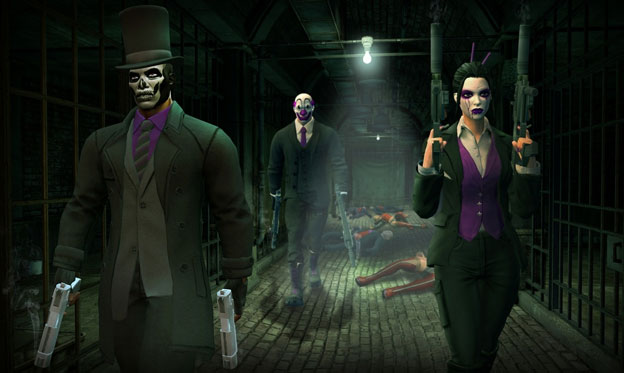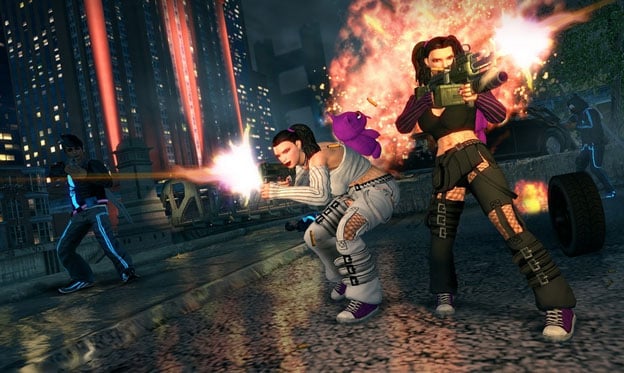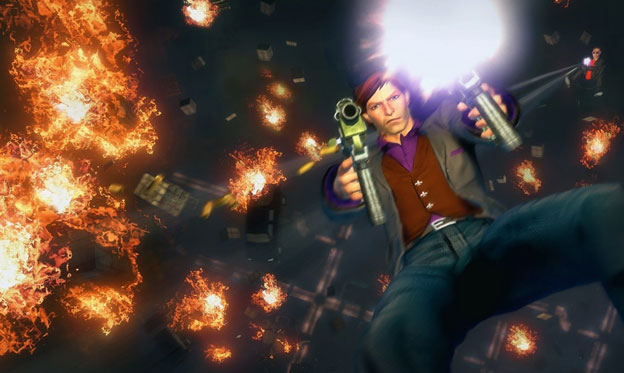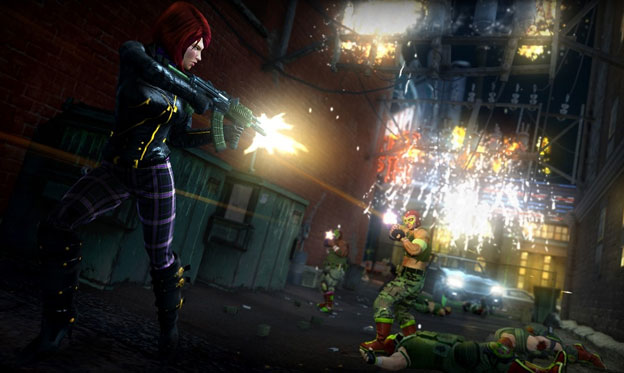The Saints Come Marching
Sandbox games are a strange breed. Traditionally, games have been a linear passage from a starting point to a set endpoint. One path, however jagged or curved it may be, that either culminated in a player’s victory or was abandoned early in defeat. Most sandbox games add a meta-game of sorts to this linear structure, allowing one to pick maybe the order of missions and take on optional bonus tasks, but doing little to throw off the shackles of a straightforward canned story. In a game that inundates a player with things to do, that allows him or her to choose activities and missions, doesn’t it naturally follow that one’s choices should ultimately influence the outcome?
This is the theory on which Saints Row: The Third is predicated. Whereas previous entries told multiple, parallel-yet-distinct stories and then tied them together in an ending sequence, Saints Row: The Third tells one story with a large cast of important characters, intermingled and interspersed. In servicing this story, the game’s illusion of choice is severely diminished. There are usually fewer missions from which to choose at any given time than in past games, and many of them are very short offshoots of the main tale. The fact that the game offers more real choice than either of its forebears is just one of the game’s many paradoxes.

What do I mean by real choices? Saints Row: The Third gives the player either/or decisions at the ends of some of its grander missions. These choices don’t influence an arbitrary morality meter, each instead offering immediate, pragmatic benefits for having chosen it. When I play a “moral choice” RPG, I have trouble taking the renegade/closed fist/dark side route, and will immediately gravitate toward options that are clearly good or neutral. Saints Row: The Third gave me genuine pause, while I considered not only the gameplay benefit of any given choice, but also what that decision would mean to the Saints in the context of the story thus far. They’re well-planned choices that have a definite and understandable effect on your relationships with other characters in the world.
That said, there are only a handful of such decisions in the game and, while there are multiple endings, which of them a player gets hinges entirely on one choice made very close to the end of the game. In fact, after finishing the story, the game automatically saves prior to that choice and informs the player that it has done so specifically in case they want to see the alternate ending. It’s unfortunate that more wasn’t done to create distinct paths through the game based on one’s choices, or to create a truly dynamic mission infrastructure based on factors such as these key decisions and city control. That, however, would have run counter to the game’s tighter focus on its story.

Saints Row: The Third is primarily a tale of revenge, but one told in the Saints Row fashion: over-the-top and filled to the brim with violence and mayhem. There’s a new city—the city of Steelport—for the Third Street Saints to explore, and a new overarching enemy (referred to by the incredibly generic nom de plume of “The Syndicate”) to spur the Saints to conquer it. The Syndicate is composed of a stable of three gangs: the Morningstar, the Deckers, and the Luchadores. However, while the game is initially centered around this big baddie and the damage one does to it, the focus softens considerably in the second act as gang activity, as a whole, comes under fire from a government-supported occupying military force. Soon enough, you’re not entirely sure which villain you’re fighting and why, or even who is working with you or against you. Allegiances shift with little question from the protagonist as to the veracity of his newfound allies’ loyalty. It’s made all the more disappointing by the sharp writing, which has some incredible gems and does a lot to flesh out the key individuals in the Saints.
The story of the game doesn’t have to be superb, though, it only has to provide a framework for the bombastic action, and excuses for some of the most ridiculous set pieces in gaming history. There are multiple instances in which a player is free-falling at thirty-thousand feet after having vacated a jetliner, gunning down incredibly persistent enemies as they all plummet toward the earth in unison. The game opens with a bank heist that culminates in airlifting the vault via chopper, the player hanging from the lines that secure the vault to its conveyance while shooting down SWAT team members and other helicopters . All the while, the SWAT team demands that the Saints surrender, but not without signing their guns. It only escalates from there, though the fame of the Saints is downplayed more over the course of the game, their public image addressed in only a few missions and throwaway lines.

But, I’m sure you’re wondering how it plays. Well, it’s very similar to the last game in actual gameplay, though the controls have been remapped a bit and the aiming feels a little looser. That may actually be a result of the frame rate, though.
The trimmings of combat have been altered: gone are fighting styles, but heavy, barehanded melee attacks now provoke beatdown sequences. These are accompanied with pseudo-quick time events that increase the Respect—which is used to earn upgrades from an extensive upgrade tree, all of which have the additional cost of cash money—gained from the beatdown, but apparently not its damage. Further, these can’t be used against the major new enemy type: Brutes. They’re massive, thuggish men who take an obscene amount of punishment, shrug off bullets, and knock you around like a rag doll. Some are outfitted with Gatling guns or flamethrowers, the latter of which are probably the most frustrating enemies in the game, though the Brutes in general simply aren’t fun to combat. Since they soak up damage like sponges, only a few of the game’s varied weapons actually have a noticeable effect on them other than to bring their life bars down.
That selection of weapons is, by and large, the game’s bread and butter. While there are the standard pistols, assault rifles, and shotguns of any good shooter, the special weapons are where Saints Row: The Third truly goes for the absurd. Reaper drones, mind-control squid launchers, a baseball-bat-sized purple “marital aid,” and a sonic blaster are just what immediately come to mind. The last, in particular, if charged up, disintegrates enemies immediately in a burst of blood. When the military shows up partway through the game, they bring with them additional vehicles, including a number of VTOL aircraft and powerful tanks that players can hijack and joyride, all of which control tightly (unrealistically so, but that’s to the game’s benefit).
The side-missions, on the other hand, seem to have been pared back from previous entries. While there are some truly standout concepts in the main story arc (//deckers.die and Murderbrawl XXXI are personal favorites), most of the other activities just task players with driving to a location and shooting some people. Sometimes the people come to you, instead. Also, when the game first gives the impression that it’s opening up, it takes the opportunity to introduce you to its entire retinue of side-missions, few of which are of any lasting value (though Mayhem missions return and Trail Blazing is a blast, as is Dr. Genki’s Super Ethical Reality Climax , a game show that involves shooting mascots and avoiding flames and electricity).
All of this is powered by a new engine that looks, for lack of a better term, glossy. It’s a good thing, in that the graphics have character and don’t appear overly staid, and the darker color palette of Steelport feels appropriate (though the crumpling effect on damaged vehicles is a little hit-or-miss.) But the engine sometimes seemed to be too much for the hardware to handle. On the Xbox 360, at least, the game would consistently chug when driving at high speeds, never to the point where it seriously affected gameplay, but it became apparent during less visually demanding sequences, when the game’s frame rate spiked, that aiming was definitely affected by a sort of visual lag.

Sound-wise, stuff blows up well and gunfire is satisfying; melee attacks have a meaty crunch to them, to the point where it can draw a wince when the protagonist delivers a particularly deadly soccer kick to a downed enemy’s head. The soundtrack is mostly composed of licensed music, all found on the radio except during specific mission sequences that just seem to call for a certain song. At those times, the developer’s choices generally adhere to the title’s absurdist nature. Joe Esposito’s “You’re The Best” while chainsawing through hordes of Mexican wrestlers at a pay-per-view event? Very Saints Row.
Lastly, there are the multiplayer options. No competitive play, here, unless leaderboards count. The Whored mode offers wave-based enemy slaying, but it feels pretty bare when compared to the tower defense-infused Horde mode in Gears of War 3. It’s good for a laugh or two, though. The crux of multiplayer in Saints Row: The Third, however, is its co-op campaign. Besides being jump-in/jump-out, and allowing players to bring their own characters along for the ride, it consists of the entire single-player campaign, played with a partner. Players aren’t forced to stick together, able to go wherever they wish in the open world, though they are given the option to tackle missions together when one player activates them. It’s a lot of fun to just run around with a buddy and wreak unchecked mayhem and destruction. Or, you know, play through the missions.
The big issue I have with Saints Row: The Third is that it doesn’t feel like its content, varied though it may be, has much of a purpose outside of the main campaign. The open world really seems to exist more as a way to prolong the experience by forcing a player to travel to the origin point for the next mission rather than simply having it begin outright. While it can be enjoyable to unwind by just cutting loose in the sandbox, the world isn’t densely packed enough with compelling, secondary content to draw the player’s attention while they’re traversing the city from point A to point B. Saints Row: The Third is still a lot of fun to play, and it absolutely takes its story-telling and presentation to the next level, but it feels like a step backward for the series with regard to justifying itself as a sandbox experience.
RATING OUT OF 5 RATING DESCRIPTION 4.2 Graphics
The design is largely excellent, but the crumple effects just look so strange at times and the frame rate is mediocre throughout. 4.5 Control
It might take a little getting used to, but the controls were largely intuitive and logical. Quick time events could respond to inputs better. 3.8 Music / Sound FX / Voice Acting
While the sound effects and music choices are good, there are disappointingly few tracks for the radio and I never came across a store where I could purchase more. Also, sometimes celebrity voices can hurt more than help (though everyone should keep an eye out for Steelport’s mayor.) 3.4 Play Value
While it’s a big game world, most of what’s there just feels like busywork. The plotline itself lasts for about nine hours, and the Whored mode will probably last most people a few more at most. 3.9 Overall Rating – Good
Not an average. See Rating legend below for a final score breakdown.
| Review Rating Legend | |||
|---|---|---|---|
| 0.1 – 1.9 = Avoid | 2.5 – 2.9 = Average | 3.5 – 3.9 = Good | 4.5 – 4.9 = Must Buy |
| 2.0 – 2.4 = Poor | 3.0 – 3.4 = Fair | 4.0 – 4.4 = Great | 5.0 = The Best |
Game Features:
